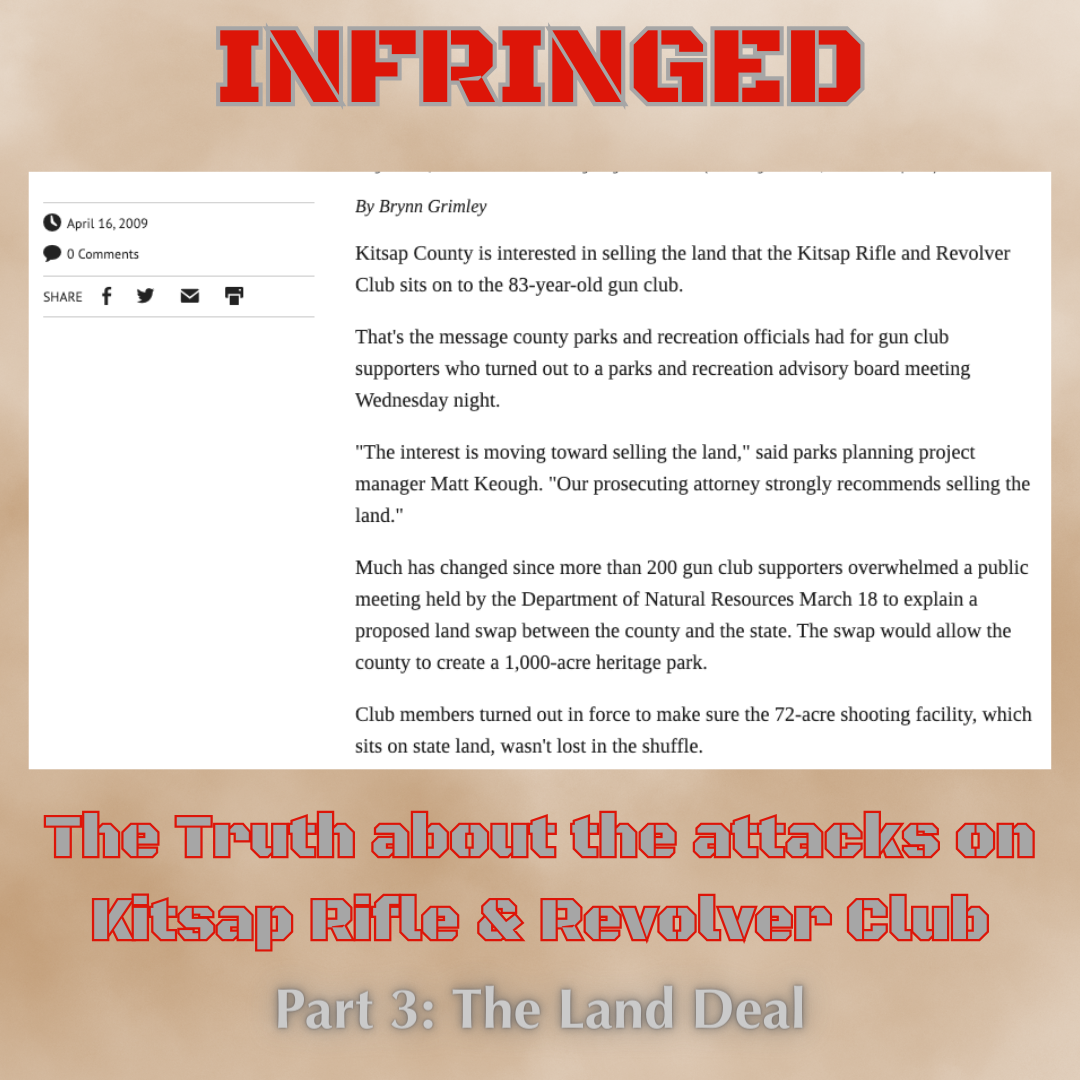Co-authored with Marcus Carter
This is the Infringed blog series. If this is your first time seeing it, please start here at Part 1.
This will be a slight overview of Part 2, but we do reveal the motive that Kitsap County officials had in agreeing with the state to sell KRRC that land it had used since 1926 as part of the County’s acquisition of the DNR land north of the gun club. This article lays the foundation for future segments that discuss a permitting investigation by the county; and the first of two lawsuits.
In 1990, Washington State implemented the Growth Management Act. It required local and state governments to identity and protect critical areas and natural resources. Environmental awareness and proactive measures aren’t limited to just elected officials, though. Current KRRC Executive Officer Marcus Carter, at the time the Club’s vice president, was made the club’s range development chairman. The Club paid for him and others to take several classes covering environmental issues, management, and safety for gun ranges.
Marcus was the person who first learned from Larry Cote, a 1993 Kitsap County Parks Planner, that the County was going to get the Club shut down as part of their long term parks plan. Had he known Marcus at the time, he might not have so brazenly declared it at the public informational event he was at.
It is important to keep in mind that the Club had a great relationship and reputation with the community, state and federal governments, major shooting organizations, etc. Our history includes training tens of thousands of civilian, law enforcement and military personnel in everything from basic home firearms safety to advanced tactical and sport shooting. We’ve held many championship level competitive matches and produced from our own membership competitors that have won local, state, regional, national and world championships. Millions upon millions of rounds of ammunition have been fired at the KRRC ranges without an issue off site. We’ve held hundreds of classes in conjunction with the Navy, National Guard, Kitsap County Sheriff’s Office and others. Our reputation was such that the Joint Base Lewis-McCord Commander, Col. Hodges, asked that we develop and execute action shooting 3-gun matches for civilian and military law enforcement, as well as designing a specialized course of fire for the Air Force JTAC Special Operations team shooting competitions. Of all the gun cubs around the nation, KRRC arguably has had some of the most capable instructors, competitors and range officers in the world.
At roughly the same time in 1993 and 1994, without any notice whatsoever, Kitsap County mandated through an ordinance that the Club’s President appoint a representative on the committee for proposed ordinance 50-B (1993), which was to surpass the existing ordinance for shooting in the county, 50-A (1985). At this point, a little reminder from Part 2 is in order. The county was trying to propose a ban on shooting throughout much of the county lands; and limit it to larger parcels on private properties. Hundreds of concerned citizens opposed the idea at a public hearing. With the backdrop of deputies at parade rest, Commissioner Win Granlund promised the shooting ban would happen one way or another, “whether you like it or not.”
It was at that time that the County was actively seeking a “land swap” with the State Department of Natural Resources (DNR) for hundreds of acres, including the land occupied by KRRC. By strange coincidence, the Club received notice that its yearly lease was to increase, based on the “value of the property.” Up until that time, the Club had an established long-term lease with DNR, which was always subject to review for the actual lease amount paid each year. The cost was to double the first year after the notice and then increase each year till it hit ~$28,000 per year. The Club pushed back and with some help from Doug Sotherland, who had been voted in as lands commissioner, they were able to secure a 15-year lease at the rate it should have been in the first place. The County was told at that time that unless they got the Club on board with the land swap, it wouldn’t happen.
At the County officials’ urging and with the promise of helping with a possible relocation, Marcus and fellow club member Bill Gremmert went out looking at potential properties for that purpose several times over the next six months, all to no avail. During one visit to KRRC, in which Marcus pointed out the win-win for all parties to include KRRC as a “top notch shooting park” as part of the Heritage Park, Larry Cote again reiterated to the Club officers that it would be better if KRRC simply moved somewhere else.
“Where exactly would you suggest we go?” Marcus asked.
“How about out of Kitsap County?” came the deadpan reply. “We are a bedroom community for Seattle. This heritage park (what is now Newberry Hill Heritage Park) will be like Central Park in New York.”
You know what? That wasn’t the last time a county official made that statement. Years later, Commissioner Josh Brown made a nearly word-for-word comment, albeit with a much snarkier tone.
The County eventually lost a window for a grant in their first push for the land swap. The State was looking out for its tenants and wanted to ensure the Club continued to thrive. A few years later the lessons the Kitsap County Department of Community Development learned about deadlines would surface much more nefariously.
As pointed out in our 2011 court trial’s defense opening statement, the County was more than happy to agree with the State to sell KRRC the leased 72+ acres. They had an ulterior motive in mind. Just a few months before the deal finally happened, in March of 2009, the County appraiser reported that the potential liability for cleaning up the land that state had been leasing KRRC could cost up to $3 million. Once again, the threat of loss of grant money for timing reasons was motivating Kitsap County to move fast. The attorney who handled the land deal for KRRC testified that the County’s designated representatives were pushing for the deal to close quickly. Of interesting note is the indemnity provision the County had demanded in the deal for land that they would essentially own for just a few seconds, based on a cleanup appraisal they had conducted internally. They had disclosed the appraisal as part of the land deal, but the County did NOT disclose that they were conducting a year’s long investigation into their perceptions that the Club had conducted un-permitted work on a new rifle line project. All of that will be more greatly detailed in future segments.
It’s all part of the trial record, folks. And it is just the tip of the iceberg.
Here’s our future plans for this series: We will start laying out the full details from that 2011 trial next, the case we members call “Kitsap 1.” As older details of things from the decade + before that become relevant, we will go back and bring those in at that juncture. But the several coming articles about the trial… well, they’ll be enough to convince you that you’ve never heard the full story from the Kitsap Sun or the County officials to say the least. And even then there will still be more. There’s the “driveway” incident. And there’s the case we call Kitsap 2. That’s the one that involves a brand-new operating permit requirement the County enacted. And since that case ruled against us, we’ve tried in good faith three times to apply for the required site development activity plans, and the local DCD office refuses to process them because the Court is not compelling them to do so. But I’m getting ahead of myself.
All I can say is, buckle up.
Coming up:
We’ll highlight the steps the club took work with the state (who owned the property at the time) to move and lengthen the rifle line. This will lead to an interesting story of a motivated County employee and the questionable actions he took to make his case. This will lead to several pieces on the initial lawsuit and trial.
Want to help? Share this blog post!

